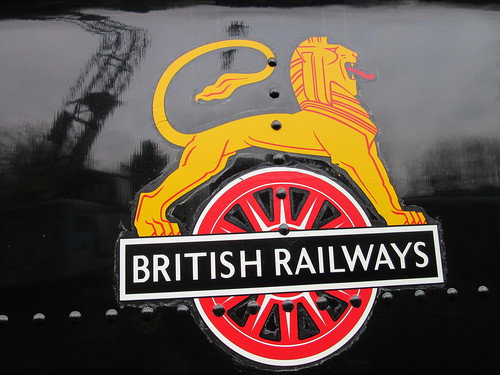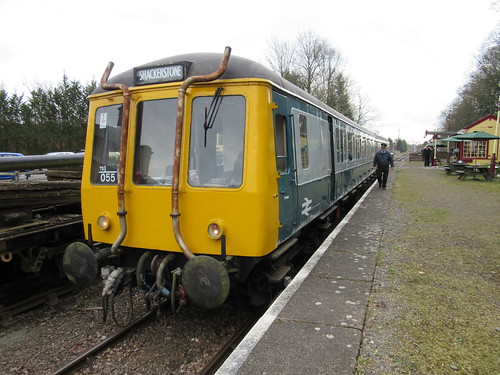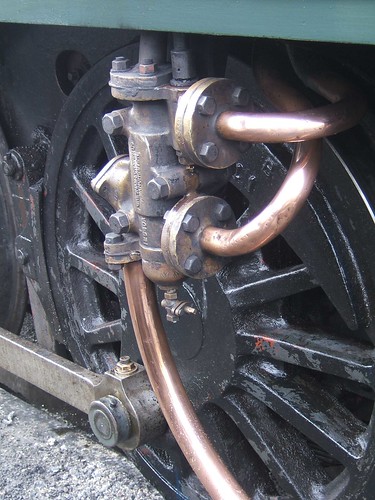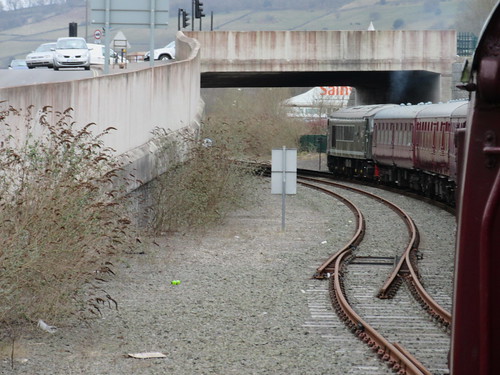skip to main |
skip to sidebar
On Easter Saturday 4th April 2015, I was booked out on '3803' with Dave as fireman. We both set-to to prepare the locomotive, Dave concentrating on steam-raising whilst I 'oiled round' and carried out the 'Daily Exam'. It can get rather smokey inside the shed so, as soon as we had sufficient steam to move the locomotive safely, I moved the engine outside.
 3803 outside the shed at Shackerstone.
3803 outside the shed at Shackerstone.
3803 looked very business-like in her new unlined black livery (thanks to Jason's hard work) with the original British Railways insignia on the tender, which we used to call the 'Lion astride a Mangle-wheel'.

There were spare vehicles attached to the passenger stock in platform 2 and an '04' shunter. I'd worked out how we could shunt them out of the way with '3803' but Adrian arrived and carried out the shunt, allowing us to move across to our train in platform 2 in plenty of time for the first departure at 11:15. The locomotive carried a special headboard 'EASTER EGGS-PRESS'.
Leaving Market Bosworth on the first service, there was a bit of a 'thump'. Since the locomotive had suffered a run of broken springs, any loud noise from 'underneath' triggered an inspection of springs at the earliest opportunity but at Shenton Dave's examination found no problem and I thought the noise was probably from the intermediate buffers between engine and tender which were known to produce the occasional 'bang'. However, on the second trip as we left Market Bosworth, I caught a glimpse of an odd-looking 'lump of metal' in the cess and spent the rest of the journey to Shenton trying to decide what it might have been. I'd more or less worked it out by the time we stopped at Shenton, so I climbed down and found one spring hanger on the middle tender axle missing. After a telephone discussion with Adrian, we ran round and gently worked the train back to Market Bosworth, where Adrian met us and we made an unsuccessful search for the missing spring hanger. It was agreed that we would cautiously work the train back to Shackerstone where Adrian would attempt a temporary repair.
To prevent a long interruption to the service whilst the repair was carried out, it was decided that I'd 'fire-up' the Diesel Multiple Unit (DMU), running as a single-unit railcar attached to a motor car from the 2-car set). Leaving Market Bosworth on the way out, we kept a sharp look-out and, this time, located the broken spring hanger which Dave lifted on board. Dave drove the DMU back to Shackerstone since he was training to pass-out as a DMU Driver.
 The DMU pauses at Market Bosworth on the way back to Shackerstone.
The DMU pauses at Market Bosworth on the way back to Shackerstone.
We disposed of the DMU on the railcar siding and returned to '3803', where Adrian had carried out a splendid repair. I've never heard of a spring hanger fracturing on a Great Western pattern tender before.
 The temporary repair to the spring hanger on the middle tender axle, driver's side.
The temporary repair to the spring hanger on the middle tender axle, driver's side.
The final trip of the day was carried out with '3803'. Dave drove out to Shenton (he's also training to pass-out as a steam driver) and I drove back. A tiring, but very interesting, day.
 '3803' ready for action on the last round-trip.
'3803' ready for action on the last round-trip.
My pictures
Easter 2015 at the Battlefield Line
I was rostered to drive at Peak Rail on Saturday, 21st March 2015. My previous turn on 1st March had encountered rain, sleet and snow (see report here): in contrast, the 21st March started dry but cold and during the day we enjoyed bright sun. Fate had other challenges, rather than the weather, to test Dave, the Fireman, and I. We had two one-hour Driving Experience courses before the service so it was an early start for me, even earlier for Dave.
'Lord Phil' certainly looked the part, standing on the outside pit in clean condition with plenty of polished brass on display and 'brewing up' nicely. However my priority was to oil round and carry out the daily exam. That meant the usual exercise of applying 'motion oil' to the six crankpins, the various oil boxes and oil pots, leaning in between the frames to reach the oil cups and oil holes on the motion. This usually involves climbing up onto the foot framing, dealing with the accessible oiling points, then climbing down to the ground and up again in various positions until most oil points are dealt with, leaving perhaps a few locations to be reached whilst in the pit underneath the locomotive whilst at the same time inspecting springs, motion and, well, everything.

Fireman's side Injector on an 'Austerity' ('Royal Pioneer').

Fireman's side Combined Steam and Delivery Valve and 'Klinger' Gauge Frame on an 'Austerity' ('Royal Pioneer').
There's a PDF of the Davies and Metcalfe publication 'Monitor Type Locomotive Live Steam Injector' here which will repay careful study. Relevant to 'Lord Phil' are the Combined Steam and Delivery Valve (on page 20) and the Non-Lifting Live Steam Injector 'Austerity' type (shown on page 22).
Dave knew there had been problems previously with the fireman's side injector failing to shut off properly after use resulting in steam and/or water discharging from the overflow pipe. The injector on the driver's side wasn't much better but we agreed to see how things went during the first Driving Experience course. When people are looking forward to a driving experience, may have travelled a considerable distance and, often, incurred accommodation costs, I hate to disappoint them, but, of course, safety is always the top priority. I do remember having to declare a failure on 'Royal Pioneer' when the regulator linkage in the steam dome became detached - that's described here.
We were having serious trouble with loss of water but we managed to complete the two driving experience courses and then attempted to water before the first service train, using the brown water tank at the south end of the platform only to discover that the brown tank wagon was out of water. I discussed with Gordon the easiest solution and we agreed to swop the engines round, with 'Penyghent' on the south end and 'Lord Phil' on the north end. This meant that we could reach the Grey water tank at the north end of the platform which is currently little-used. The grey water tank is much easier to use (provided you stop in the right place), because, instead of dragging a long fire hose around, there is just a hinged delivery pipe which swings across to the tank filler. This also gave a bit of variety in that we hauled the train uphill, rather than downhill, and did so bunker-first.
 'Lord Phil' at Matlock, ready to haul the service train back to Rowsley.
'Lord Phil' at Matlock, ready to haul the service train back to Rowsley.
Neither Dave nor I thought the arrangements ideal but we managed to run the service all day. One or two people enquired about the locomotives being the opposite way round to normal.
 Peak Rail: 'Penyghent', unusually on the south end of the train, approaches Matlock, viewed from 'Lord Phil' on the north end.
Peak Rail: 'Penyghent', unusually on the south end of the train, approaches Matlock, viewed from 'Lord Phil' on the north end.
I think this was Penyghent's 'swan song' before being taken 'Out of Traffic' for a major overhaul.
My pictures
Peak Rail 2015.
 3803 outside the shed at Shackerstone.
3803 outside the shed at Shackerstone.

 The DMU pauses at Market Bosworth on the way back to Shackerstone.
The DMU pauses at Market Bosworth on the way back to Shackerstone.
 The temporary repair to the spring hanger on the middle tender axle, driver's side.
The temporary repair to the spring hanger on the middle tender axle, driver's side.
 '3803' ready for action on the last round-trip.
'3803' ready for action on the last round-trip.




